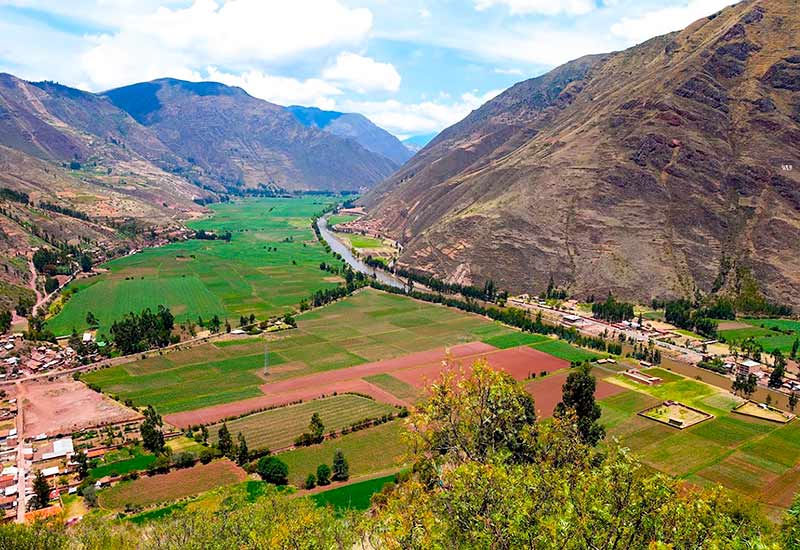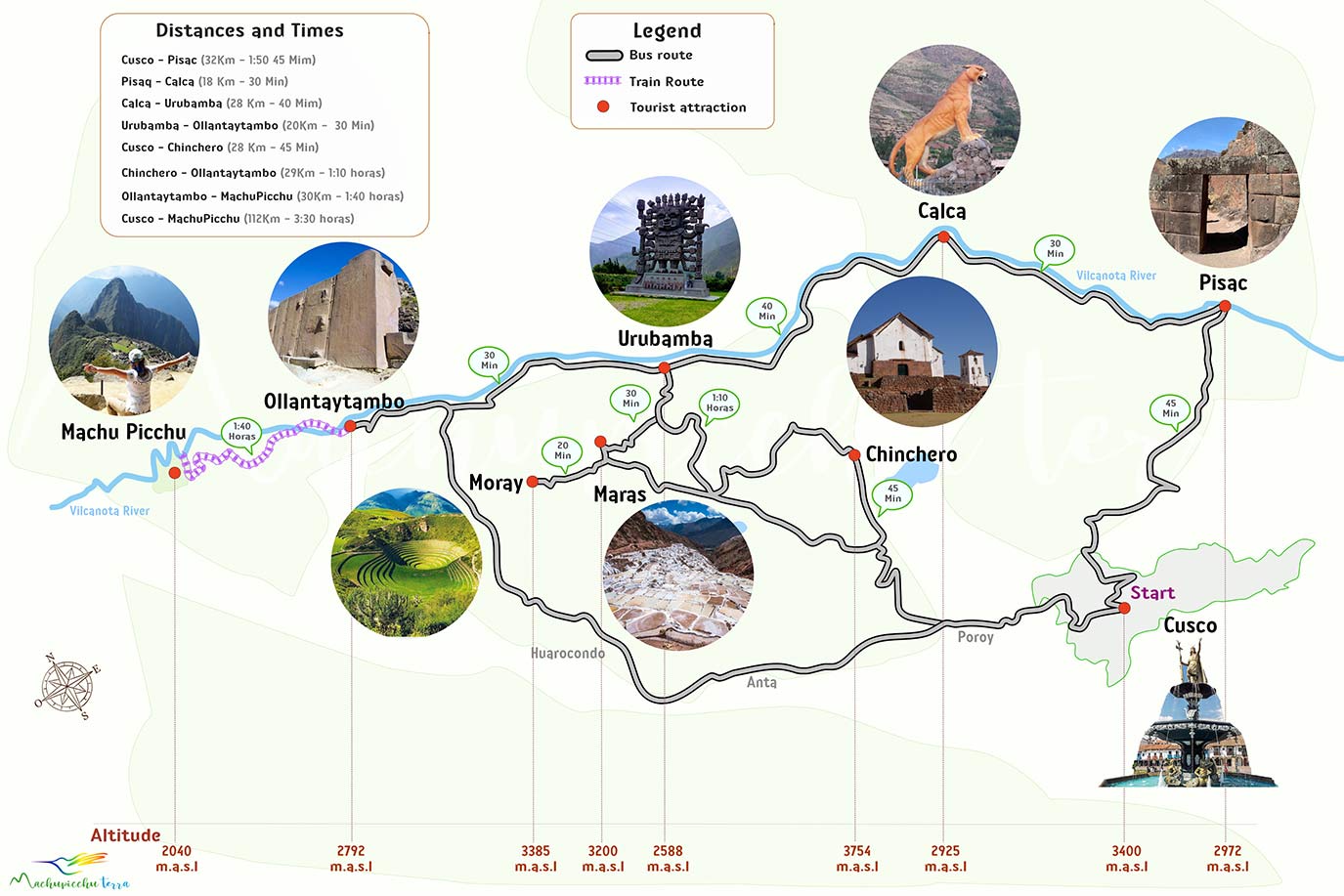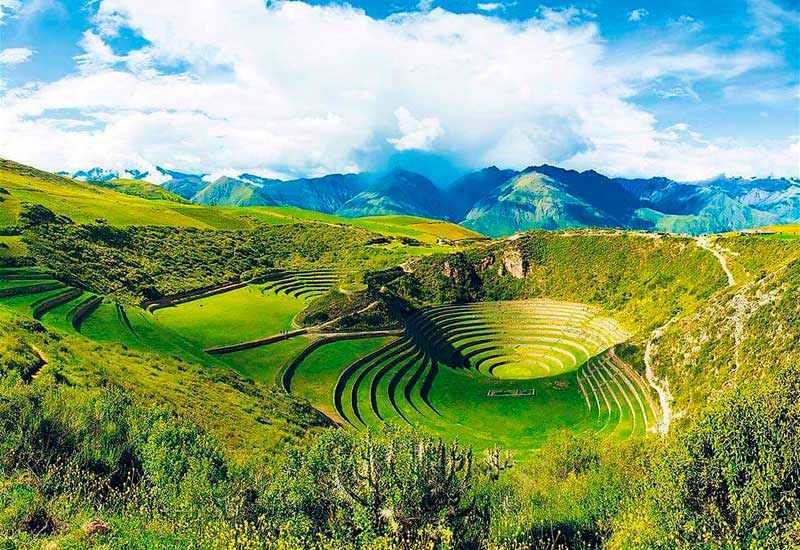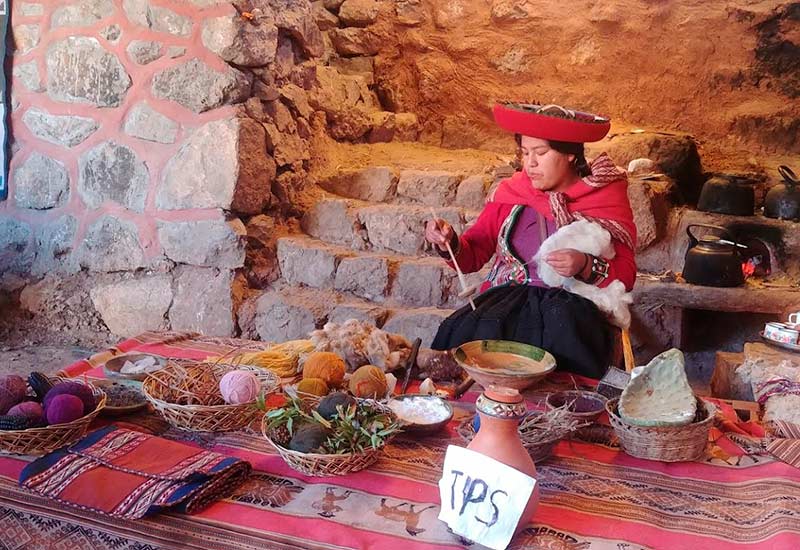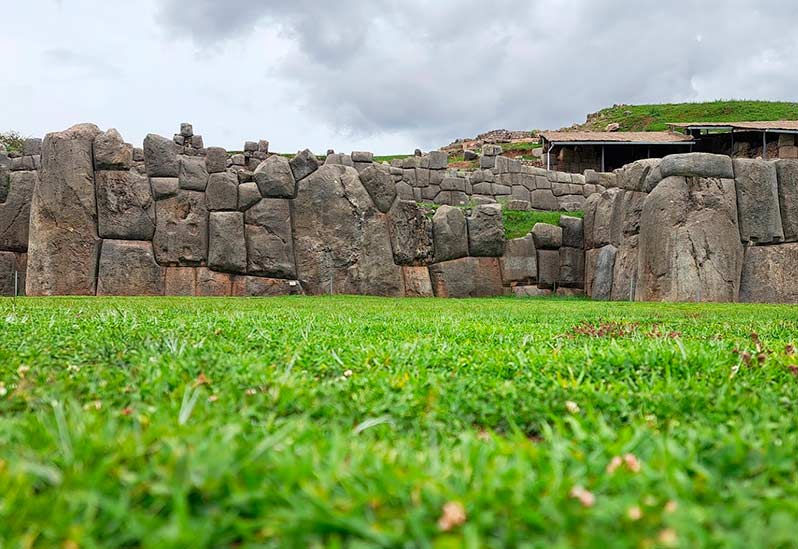Travel guide to the Sacred Valley in Peru
The Sacred Valley of the Incas is truly one of the most amazing places in Peru and South America. Its wide fertile territory was a sacred place where the Incas built their most important citadels and temples, such as: Pisac, Ollantaytambo, Chinchero, Moray and much more. Today it is one of the best tourist destinations in Cusco along with Machu Picchu.
- What is the Sacred Valley of the Incas?
- The geography of the Sacred Valley
- The towns and tourist attractions of the Sacred Valley of the Incas
- The history of the Sacred Valley
- How to get to the Sacred Valley of the Incas?
- Map of the Sacred Valley of the Incas
- What tours to choose to travel to the Sacred Valley?
- When to go to the Sacred Valley?
- Tickets needed in the Sacred Valley
- How much does the 1-day trip to the Sacred Valley of the Incas cost?
- What to do in Pisac?
- What to do in Ollantaytambo?
- What to do in Maras?
- What to do in Moray?
- What to do in Chinchero?
- What to do in Urubamba?
- How to combat altitude sickness in the Sacred Valley?
- Photo gallery
What is the Sacred Valley of the Incas?
The Sacred Valley of the Incas is a geographical area close to Cusco surrounded by mountains, fertile lands, snow-capped mountains, lagoons and a lot of history.
There the Incas built their main citadels and temples. In addition, they built thousands of terraces and terraces where they grew different agricultural products, especially corn.
Today the Sacred Valley of the Incas is a very touristic area that includes Andean towns such as: Pisac, Chinchero, Urubamba, Ollantaytambo, Lares, Yucay and Maras.
The hundreds of terraces and terraces built by the Incas more than five hundred years ago are still visible. Thousands of tourists visit the archaeological sites of Chinchero, Ollantaytambo, Pisac and more.
The geography of the Sacred Valley
The Sacred Valley of the Incas is a geographical area close to Cusco surrounded by mountains, fertile lands, snow-capped mountains, lagoons and a lot of history.
It is located to the northeast and next to the city of Cusco in a space of fertile land on the eastern side of the Andes Mountains. It covers an area of thousands of hectares, mainly in the valley of the Vilcanota River (also called Urubamba).
It extends from the high mountains above 4 thousand meters above sea level, to the fertile valleys of the Urubamba at an altitude of 2 thousand meters above sea level. There, the main product grown was corn. It is even assumed that the largest and tastiest corn in Peru is produced in the Sacred Valley of the Incas.
The Sacred Valley is an area of great importance for the Incas due to its geography surrounded by Inca gods, such as the mountains, the river, the lagoons and more. The snow-capped Salkantay, Verónica, the Huaypo lagoon, Piuray, the Vilcanota river and more stand out.
Throughout this vast and important geography, the Incas built their most important citadels such as: Pisac, Ollantaytambo, Chinchero and nothing less than Machu Picchu.
The towns and tourist attractions of the Sacred Valley of the Incas
These are the most touristic towns and archaeological sites in the Sacred Valley of the Incas:
- Pisac.- It is a town and archaeological site located 34 kilometers from the city of Cusco. The town is famous for its craft centers where silver jewelry is made. Its archaeological site was a large Inca citadel with large platforms and terraces. It has temples, royal enclosures, enclosures of common settlers and even cemeteries. The entrance is with the Tourist Ticket of Cusco.
- Ollantaytambo.- It is a town and archaeological site located 61 kilometers from the city of Cusco. The town is famous for its streets that have maintained their urban structure since Inca times. Ollantaytambo is also famous for hosting the train station that leads to Machu Picchu. Its archaeological site was an urban and religious center that until today maintains important buildings such as the Temple of the Sun, the Enclosure of the 10 Niches and the Baños de la Ñusta.
- Chinchero.- It is a town and archaeological site located 30 kilometers from the city of Cusco. The town is famous for its archaeological site (with platforms, terraces, smaller enclosures and a colonial church), the former palace of the Inca Túpac Yupanqui, as well as for its textile centers and beautiful Andean landscapes where the Piuray and Huaypo lagoons stand out. The entrance is with the Tourist Ticket of Cusco.
- Urubamba.- It is a town, capital of the province of the same name, located 53 kilometers from the city of Cusco. It is famous for its excellent tourist services with hotels, restaurants, bars and more. There you can also practice adventure sports such as canoeing, ziplining or even paragliding. Urubamba has a pleasant climate for tourists, which is why many tourists decide to stay there.
- Maras.- It is a town located 41 kilometers from the city of Cusco. It is famous for two highly visited tourist attractions: the Salineras de Maras and the circular platforms of Moray. The first is a set of more than a thousand naturally formed salt pits. The second is a set of circular terraces built by the Incas as an agricultural laboratory. The entrance to Maras is bought in the same place (15 soles). The entrance to Moray is with the Cusco Tourist Ticket.
- Lares.- Lares is an Andean town located 108 kilometers from the city of Cusco. It is famous because the 4-day trekking route to Machu Picchu called the ‘Lares trek’ begins there. In addition, there are the thermal baths of Lares, one of the best in Cusco. The entrance is acquired in the same door of the place. The Lares trek can be done with a tour or on your own.
- Calca.- It is a town, capital of the province of the same name, located 51 kilometers from the city of Cusco. It is famous for the archaeological site of Huchuy Qosqo, its thermal baths and hot weather.

Beautiful view of the Sacred Valley of the Incas
The history of the Sacred Valley
Before the Inca occupation, the area occupied by the current Sacred Valley was occupied by Andean ethnic groups. Then the Incas timidly advanced until with the coronation of Emperor Pachacutec, the Incas took control of this vast geographical area.
With the Inca government, the Sacred Valley was used as farmland mainly for corn. They also built important citadels among which Pisac, Ollantaytambo, Urubamba and Chinchero stand out.
The Incas believed that the Vilcanota River represented the milky way. Thus, the entire area of the Sacred Valley, bathed by the waters of the Vilcanota, took a leading role in the Tahuantinsuyo empire.
In the second half of the 16th century, after the arrival of the Spanish, the Sacred Valley witnessed bloody clashes between the Spanish and the Incas led by Manco Inca. The toughest confrontations occurred in Chinchero (it was set on fire) and Ollantaytambo (part of its structures were damaged).
Manco Inca fled following the course of the Vilcanota River and settling in Vilcabamba (known as the last refuge of the Incas).
After Spanish rule, the Inca citadels became Indian reductions. After that in Andean towns. Currently, the Inca archaeological sites are still preserved, as well as the Andean towns.
The Sacred Valley of the Incas today is one of the most touristic geographical areas of Cusco. The most visited sites are Pisac, Urubamba, Ollantaytambo and Chinchero. All can be visited with the famous one day tour to the Sacred Valley of the Incas.
How to get to the Sacred Valley of the Incas?
- The Sacred Valley of the Incas is made up of the towns of Pisac, Chinchero, Maras, Urubamba and Ollantaytambo.
- Of these towns, the closest to the city of Cusco is Chinchero (30 kilometers). Then follow Pisac (34 kilometers), Maras (55 kilometers), Urubamba (60 kilometers) and Ollantaytambo (79 kilometers).
- To get to the Sacred Valley of the Incas there are 2 routes: a) route through Chinchero and b) route through Pisac.
If you travel to the Sacred Valley of the Incas on your own, these are the ways to get there:
In “collective” cars – The collective cars are taken in Pavitos street (to go through the route via Chinchero) and Puputi street (to go through the route via Pisac). The cost of the trip is around 10 soles (3 USD).
By bus – The buses that leave from Cusco to Ollantaytambo are taken on Pavitos street. The cost is 10 Peruvian soles per person (3 USD). The buses that leave from Cusco to Pisac are taken on Puputi street. The cost is 5 soles per person (2 USD).
In taxis – Taxis can be hired on any street in Cusco. You can also hire this service through a tourism agency. The cost varies from 60 to 120 Peruvian soles (from 20 USD to 40 USD).
Map of the Sacred Valley of the Incas
- The Sacred Valley of the Incas is made up mainly of the towns of: Pisac, Chinchero, Maras, Urubamba, Chinchero and Ollantaytambo. The Vilcanota River (also called the Urubamba River) runs through most of these towns.
What tours to choose to travel to the Sacred Valley?
An organized tour will allow you to save time and travel more safely. There are 2 ways to tour the Sacred Valley:
- An organized tour
- Joining an organized group to tour the Sacred Valley is the most used way by tourists. An organized tour guarantees you reliable drivers, qualified guides and a comfortable trip. The tour begins with stops in the town of Pisac, Urubamba, Ollantaytambo and Chinchero.
- A private tour
- A private tour gives you greater flexibility in the itinerary and in the time you can stay in each place. This service can be organized from 1 tourist. This tour is a good option for the family, couples or group of friends.
The Sacred Valley + Machu Picchu tour is one of the favorites for tourists. This service lasts 2 days and covers the archaeological sites of Pisac, Ollantaytambo and Machu Picchu. In addition, it includes 1 hotel night in Aguas Calientes, the train trip and 1 buffet lunch in Urubamba.
When to go to the Sacred Valley?
- The Sacred Valley is beautiful at any time, be it during the dry season (April to October) or the rainy season (November to March).
- The rainy season it is characterized by the greater frequency of precipitations while the dry season by the absence of rains.
- The dry season It is characterized by few rains. In those months, the sun is more intense during the day and the cold is more icy at night.
- According to tourists who have already visited the Sacred Valley, the dry season is a good time to visit Chinchero, Pisac, Urubamba, Ollantaytambo and all the towns that make up the Sacred Valley.

Road leading to Ollantaytambo in the Sacred Valley of the Incas
Tickets needed in the Sacred Valley
- To visit the main archaeological sites of the Sacred Valley you need the Cusco Tourist Ticket.
- The Tourist Ticket of Partial Cusco – Circuit 3 includes the entrance to: Pisac, Ollantaytambo, Chinchero and Moray.
- Another good option is to purchase the Integral Tourist Ticket, which includes admission to 16 different tourist attractions in Cusco, Valle Sur and Valle Sagrado.
How much does the 1-day trip to the Sacred Valley of the Incas cost?
This is the budget to travel to the Sacred Valley of the Incas on a 1-day tour or on your own on a 1-day trip.
| Budget to travel to the Sacred Valley of the Incas | ||
| Services | With tour | Without tour |
| Transport | Included | 40 S/. approx. |
| Tour guide | Included | Optional |
| Tickets | Included | 70 S/. (foreigner) / 40 S/. Peruvian. |
| Lunch | Included buffet | 70 S/. Average buffet lunch |
| Total cost | 262 S/. -72 USD | 180 S/. – 50 USD (without guide) |
What to do in Pisac?
- The archaeological site of Pisac – One of the best citadels built by the Incas. It is built on the basis of terraces of finely polished granite stone. It is also characterized by its terrace system, its altars, water wells, squares, ceremonial enclosures and more.
- The Pisac craft market –It is a craft fair established in the town of Pisac for centuries. There the tourist can find alpaca clothing, silver jewelry, paintings, souvenirs and much more. It takes place every Sunday in the main square of the town.
- The town of Pisac – This town preserves many customs of its ancestors. There you can appreciate the colorful dress of its people.
What to do in Ollantaytambo?
- The archaeological site of Ollantaytambo – It is one of the main tourist attractions of Ollantaytambo is its archaeological site. It has immense walls and stairways of various sizes. Among its constructions, the following stand out: the Temple of the Sun, the Real Casa del Sol and the Baño de la Ñusta.
- The town of Ollantaytambo – One of the towns with the most history is Ollantaytambo. Its streets, walls and squares preserve the Inca tradition combined with the colonial. It is the only town that maintains its original Inca urban design.
What to do in Maras?
- The salt mines of Maras – The salt mines of Maras are made up of hundreds of natural salt wells formed thousands of years ago. This salt was exploited by the Andean man for a long time. Even the Incas commercialized their production.
- The town of Maras – The town of Maras is famous for its church dedicated to San Francisco, at the base of which was an Inca palace. Inside there are pictures of the ‘Escuela cusqueña’. From this town we leave to visit the Salineras de Maras and the platforms of Moray.
What to do in Moray?
- The circular platforms of Moray – The circular platforms of Moray was actually an “agricultural laboratory” where the Incas experimented with the planting of different products such as coca, quinoa, potatoes, oca and more. Its platforms are circular in shape, simulating an amphitheatre.
What to do in Chinchero?
- The archaeological site of Chinchero – It was the palace of the Inca Túpac Yupanqui until the Spanish invaders destroyed it to build the village church. You can still see the walls and the terrace system of the place.
- The town of Chinchero – One of the towns with the most tradition in Cusco. Its inhabitants dress in their characteristic red and black attire. There it is still possible to barter. Its authorities are elected by the community just as their ancestors did several centuries ago.
- Textile centers – Chinchero is famous for its textile centers. There its inhabitants continue to create alpaca garments just as they did hundreds of years ago. There tourists can buy sweaters, gloves, scarves, shawls, chullos, ponchos and many other products.
What to do in Urubamba?
- Urubamba town – This town is the capital of the province of the same name. It has a pleasant climate that attracts tourists. There the largest corn in Peru is harvested. There are also high-quality restaurants where you can savor delicious Peruvian food.
- Adventure sports in Urubamba – Various adventure sports are practiced in Urubamba such as: canoeing, cycling, rock climbing, ziplining, and even paragliding.

Some of the places you can find in the Sacred Valley of the Incas
How to combat altitude sickness in the Sacred Valley?
- Altitude sickness is not a recurring problem in the Sacred Valley. However, to get to the valley you will need to go through the city of Cusco and there you do run the risk of feeling the symptoms of altitude sickness.
- This discomfort is suffered by tourists whose bodies are not used to mountain geography. Cusco is at 3,399 meters above sea level. (11,151ft). There the atmospheric pressure is low.
- The main symptoms of altitude sickness are: nausea, shortness of breath, fatigue, insomnia and loss of appetite.
- Altitude sickness usually disappears gradually after a few days of getting used to the climate of Cusco. You can also alleviate discomfort by drinking plenty of water (especially coca tea).
- To better combat the discomforts of altitude sickness, it is recommended to adapt to the climate of Cusco at least 1 day before doing the tour of the Sacred Valley.
- Some people choose to spend their first days in the Sacred Valley. This way the symptoms of altitude sickness will be less intense.
Advice from people who have been there
 By: Luis S
By: Luis S“Feel the spirit of the Incas“
“This magical valley, green everywhere you see it and located between great mountains, has archaeological sites everywhere. Everything is great, its different towns, its ruins and the access to the train that takes you to Machu Picchu. Its geography and climate are impressive for climbers and walkers; its people are friendly and always willing to help.“
By Ticket Machu Picchu – Last updated, August 15, 2024
